On numerous occasions, finds dated using this method have been news headlines and newspaper front pages in the “History” section. But really, what is carbon 14 dating? ?
First of all, we must briefly know the history of dating methods, and for this we must mention Thomsen, the archaeologist who divided prehistory into ages , differentiating the Stone Age, the Bronze Age and the Iron Age. This division was made according to the tools handled by prehistoric communities, in which an evolution can be seen. (from stone to iron) that carries with it an evolutionary change as well as in life forms and in social complexity. This system is still used today, mainly in the field of dissemination and in the first knowledge about history for the smallest of the house. And partly thanks to him, in archeology he makes a distinction between relative and absolute dating.
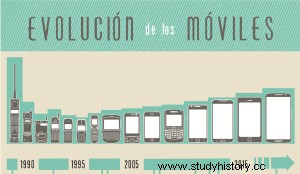
Therelative dating it would be the one made by Thomsen in the 19th century, he establishes that an object is comparatively older or more recent in relation to another object, analyzing the construction material, style, decorative motifs and a long etcetera; this differentiation is called:typological sequence . Typology is one of the main tools for contextualizing a site or a community, and until the mid-1950s, only this type of dating existed. The problem is that their results are not 100% reliable nor do they answer all the questions of archaeology. After the Second World War the “exact” sciences they were widely developed, and their applications in our field changed the course of the history of archeology completely.
The absolute dating is then born , the famous carbon 14 among them and the answers to many questions. Until then, the only thing that established absolute chronologies were the exact dates provided by the classical texts :such as reigns, deaths, births, relevant political measures or wars. But, with advances in science along with stratigraphy and the good work of the archaeologist, today it is possible to know how many thousands of years there are between a Neanderthal and a Wall Street broker.
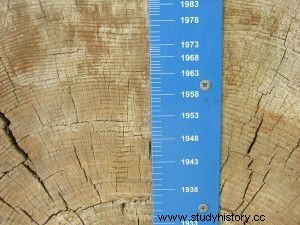
A hybrid dating method is noteworthy between relative and absolute chronology:dendroconology. It is based on the reading of the tree rings that inform us about the environment in which it developed:periods of drought, floods, the birth of the tree or its death (both naturally and if it becomes a building material). It is a hybrid method because it allows to attribute a numeric value to the tree's growth rings. It is a very widespread procedure in Europe due to its abundance and has managed to date the Anasazi culture (South America) from its beginning to its fall.
Carbon 14:operation, sampling and limitations
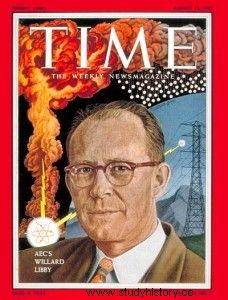
In 1949, chemist Willard Libby became interested in how old our planet was and discovered that carbon 14 could become a dating method:the atomic clock . Why? Libby, based on the experiment carried out by the physicist Max Planck , who bombarded a thin layer of silver with atoms and observed that alpha particles were released from this action (which could be read at fixed energy levels), applied the same methodology on a large scale:with the Earth. Nitrogen atoms continuously hit our planet (cosmic radiation ), and from this action radiocarbon arises. Libby realized that plants take up this radiocarbon (or C14) through photosynthesis, herbivores eat plants that have taken it up, carnivores eat herbivores, and so on up the food chain. Therefore, in life we are continually receiving carbon, but when we die , it remains paralyzed in the concentration it had at that moment and, as time goes by, the carbon number begins to reduce .
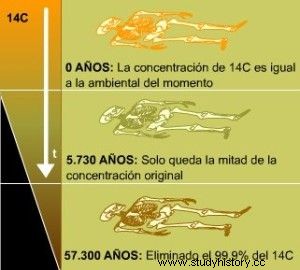
The decrease in carbon 14 occurs because in the atmosphere coexist three types of isotopes of carbon, 12, 13 and 14. 12 and 13 are stable s, they do not mutate, while 14 is unstable , which means that some of its components (protons or neutrons) move . In this molting process, what is going to be emitted is an alpha particle (what Planck discovered) which is very useful when carbon 14 is continuously formed and transformed by cosmic radiation. But a beta particle is also released from this radiation. (which is the one that would be read in the dating test). This carbon remains in the atmosphere on a regular basis and in the same proportion between the three types. But when it dies, carbon 14 begins to decay and becomes stable, passing through 13 and 12 until becoming nitrogen 14 (its origin) constantly. By measuring the carbon rates, an estimate can be made of the time that has elapsed from the death of to the present.
This transformation follows a series of stages, called half-life periods . The sample that we want to analyze is collected, which will always be from an organic residue , we send it to the laboratory and it is bombarded to extract the amounts of carbon 12, 13 and 14, the ratio is measured and the time elapsed since he ceased to be alive is deducted. The transformation ratio (or speed of transformation) experienced by carbon 14 to 12 (half-life period) is 5730 years , this means that C14 is present in half that proportion from 5730 years. If we add up those lives, with 11,460 years it will be a quarter of what there was mainly. If another third half-life elapses, 17190 years, one eighth of c14 remains. Until a time comes when there is no c14 left and cannot be operated. Therefore, it is not advisable to use this method on remains older than 45,000 years, since the dates obtained will be problematic.
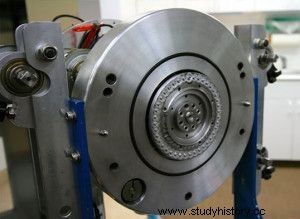
There are two methods of analysis carbon 14:the traditional which would consist of analyzing the number of beta particles, which are the ones emitted by C14 when it is transformed again, and from this, being able to estimate the number of atoms; and the most used would be accelerator mass spectrometry (AMS) , which directly counts atoms, the sample is smaller and gives more precise dates.
Handling the samples:the laboratory
To obtain a more approximate date, it is best to sendseveral samples to different specialized centers, because there are a series of protocols that each imposes to take into account that can facilitate the dating work and its results. It is very important that laboratory scientists and archaeologists maintain a working relationship and agree on the sampling strategy before starting the excavation campaign, so that the work is not discarded due to a poor sample extraction or conservation technique.
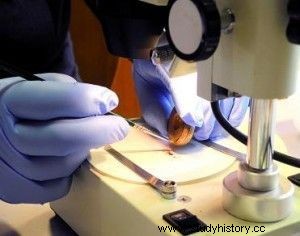
Usually, the best way to extract the sample and preserve it until analysis is with the aluminum foil without the sun giving it. When the sample is received, a preliminary analysis is made. to ensure that the sample is suitable for testing and to verify that it is not contaminated. In addition to this, it must be accompanied by an estimated date together with localization data of the site to be able to get as close as possible to the correct date and to be able to compare hypotheses with results.
The handicap of this method is that you need to calibrate the result , this calibration is performed with dates obtained from dendrochronology studies and provides those date gaps that the C14 method can deal with. Calibration is done by the archaeologist or the laboratory itself (depending on their skills) and is done toconvert the BP years to calendar years. And what does BP years mean? The expression refers to the English words “Before present ”. It was coined by Libby when she discovered this method, in 1950, therefore the age estimate is taken starting from 1950 as if it were a year 0 and everything before was "before the present". Apart from this small inconvenience, it must be taken into account that the proportion of C14 atoms has not been regular historically, there is not the same amount distributed now as before (for example, there is currently more radiation than 10,000 years ago and this will mean a different proportion ); so the results that we will handle will be approximate dates and not absolute , so it is ironic that this method is called "absolute dating".
What are the results of this method like?
In our country, the research centers such as the CSIC or universities such as Granada (UGR) have means for this analysis and on their website you can consult the prices between which a test of this magnitude ranges (between €250-500, depending on the period of time it will cost more or less ). And, outside our borders, there is a highly relevant laboratory in Miami called Beta Analytic Radiocarbon Dating ( BETA).
An sample report with the results that the laboratory would send us would be the one in the image. It offers us a date expressed as follows:2750±30 BP . This means that 2750 would be the BP date and ±30 is the margin of error that date has (about thirty years or so). Next to it, a percentage of error in which the laboratory proposes two approximate dates and a graph that represents the result.
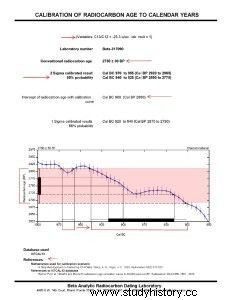
Everything points to the days of this method being numbered … In a future , the concentration of C14 on the planet will be below minimum , that carbon will not be obtained in life and, therefore, with death, the archaeologists of the future will not be able to date nothing with this method as there would be no carbon to read or analyze. This detail does not worry archaeologists today too much, although it is a method that works great for close dates (up to 20,000 years old it offers very precise results). With the advances Other techniques have been developed in this field to obtain distant dates not covered by C14. , such as the optical stimulation luminescence (OSL), the Uranium-Thorium method or the Potassium-Argon method; that allow to extend the temporary fork and will replace, time to time, radiocarbon. What will become of us without carbon? Our generation will not see such changes but hopefully they will come up with solutions that even outperform this method.
